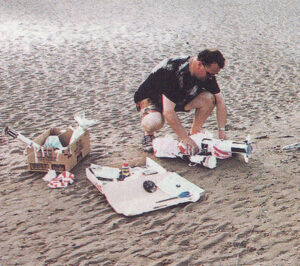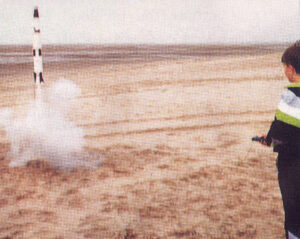
It took three matches to light the grey, Jetex fuse. With an impressive display of dexterity, Pete, Rog and I dived behind the mound of sand. The red nose cone of the 2ft. 6in. rocket pointed towards the great blue yonder. There was a whisk of smoke from the missile’s tail then – nothing!
“It’s just like the last time,” grunted my best pal Pete, raising his nose level with the top of the mound.
“Oh ye of little faith,” I think was the kind of thoughts that passed through my head. “Just give it a few more seconds,” I advised from my position face downwards in the sand. “ It’s a long fuse. Hold on a bit longer.”
“Looks like the wind has blown it out again.” Rog observed with his usual lack of caution. “ I’ll go and take a look.” Rog jumped up and headed to the launch site. “Come on then, don’t be the world’s two largest chickens.” My close friend Pete hauled me from my hole in the sand.
Pete and I (the other Pete), were commonly known to our two families as the two Petes. We had met in the summer of 1950, when we were both five. I was driving my pride and joy, a red and white racing car. With its strap-on bonnet, mock up engine and side handbrake. That car was the business. My dad just produced it out of the blue. He was brilliant at doing things like that.
From that first meeting on the bank at the foot of which steam trains clattered in and out of Southport, Pete was a bit jealous of that car. He was an only child and I was the youngest of seven. I think sometimes a bit hung up about that too, though I never found out why.
When we discovered that we were heading for the same school that autumn of 1950, our friendship began.
“Don’t get too close, Rog.” I shouted a warning to our other mutual pal Rog, as we ran over to our latest contribution to the Space Race. This red and white rocket was our third such effort during those exciting years of the late 1950s and early 1960s, that fired the imagination of schoolboys in the dawn of the age of space travel.
Just what Rog replied was drowned out by an almighty clouds of sparks and a bigger cloud of white smoke. The dead bird was very much alive! The Adas Three left the improvised launch pad. I felt that strange feeling of exhilaration as I watched it go on its first few seconds of flight. Not for long. Rog had taken off like a scared cat. The two Petes froze. The Atlas Three appeared to take an unusual interest in poor old Rog. As he bolted down the beach the rocket, with only one of its two engines working, followed him like a magnet. Any help we might have given was not available at that point in time. We were both consumed by a hysterical bout of laughter. Not the stuff of those guys at Cape Canaveral! Rog never saw the funny side of it either, then again he was never noted for his sense of humour!

With a spectacular sight, the rogue rocket crashed into the sand and disintegrated into a thousand fragments of burning balsa wood and cardboard. The flight of the Adas Three was over, and so was the result of several weeks’ effort. Rog got back on to his feet and brushed the sand from his clothes. Having recovered our sense of emotional stability, we went over to view the wreckage. It was a case of Back to the Drawing Board.
At the dawn of the space age, as school boys we watched the unfolding events with fascination on the small screen and in the pages of Right magazine, The American Saturday Evening Post and Life magazine (they cost 2/-, nearly all your pocket money). The Americans and Russians battled it out both in public and in semisecret. Our own country remained firmly fixed to the ground, having given its early lead away with the Blue Streak rocket, to the very crafty French. They guessed that Britain would lose its nerve and scrap its effort. As usual, they were right and that’s where we are today, using their rocket to launch our satellites. Yes, we have heard this story before.
To get our creations flying, acts of imagination and creative coverage were the order of the day. Our school science lessons were reflected in the ancient Victorian lab, where we spent many a mind-blowing hour. Student participation was kept to a bare minimum in those days. The Space Race was light years away to those chalk-covered souls who were in charge. But then the Rocketeers came to view the old lab with a new vision.
I do not recall exactly how I came upon the formula for gun-powder. That interesting combination of saltpetre, sulphur and charcoal became the lifeblood for the activities of the Rocketeers. Upon the dusty shelves of the school lab, we discovered the ingredients which, when combined opened the doors to rocket flights.
To keep up the supply of materials needed for a regular flight programme, we needed the assistance of a lad with stealth, tenacity and pure guts. One John Sherman and gang filled the bill. Slick hair, multicoloured socks, winkle-picker shoes, yes that boy could put the rock in rock’ n roll. Sherman and gang were not Rocketeers as such, but their knowledge of the world was wide. It was a different world to ours, but we had need of their skills. They viewed our activities with a certain detached interest, just in case it presented any new experiences they could add to their already colourful portfolio.
It was during those periods when the science master was surrounded by the faithful, that Sherman and co. swung into action. From their places on those high shelves, the botdes containing the precious substances were carefully removed. Measured amounts were transferred from bottle to paper bags. Then the botdes were replaced to their identical spots. All in the cause of the Space Race.
“I don’t believe that stuff ever works”. Sherman announced one day, in the lab, just as we had mixed a very interesting sample well out of the ageing science master.
“It will work all right, believe me,” I replied. “This improved mixture will be the best we have ever made.”
I was speaking from experience. A few days before, I had been carrying out a few fuel experiments in the garden shed. My mother eyed my unusual hobby with concern. She did not know about the fuel experiments. I had put a small quantity of the new fuel in a test stand and lit it. Only the guidance of fate saved the shed from the fire that followed. Boxes of chemicals
lay in the path of the spreading flames. I dashed to the nearest tap followed by a cloud of black smoke. The cat fled in terror having decided that was the last experiment he was going to watch, if he valued his tail. Our ex-colonel neighbour, ever interested in everyone’s business, stopped gardening to watch the drama unfolding. I dashed to and fro with bowls of water trying to look normal. Luckily the flames were extinguished, before any real damage was done. The main cause of anxiety was the colonel putting in a report to Mum. He didn’t, so he went up in my estimation.
“Well”, observed our chief supplier. “If I’m going to get any more of this stuff, I want to see what it can do.” We could hardly refuse. Sherman and gang took a very small amount of fuel in a metal dish. I watched with growing apprehension as they retreated to a dark corner of the lab. A match was produced from a blazer pocket. The brief life of the match was quickly outshone by its interaction with the fuel. Indeed the whole lab took on a new glow. Above the head of the Sherman gang, on the whitewashed ceiling, a large black patch made a sudden appearance. The result of that accident was a month’s ban from the lab for one and all.
One more memory of those wonderful days came back to me when I heard of the recent death of that hero of the Space Age Astronaut Alan Shepard. The day he flew his Freedom 7 capsule, with the Russians storming ahead of America, was a day to remember. The whole class I was in were aware of the great event about to take place on that Friday morning, May 5 1961. One of the class had brought in a miniature portable radio. We listened in to the live broadcast from Cape Canaveral. It was unfortunate that the time in Florida is some six hours behind us. This caused big problems as the moment of history arrived. The lift off to Freedom 7 was going to be right in the middle of the English Literature lesson.
The English master was a bald Welshman called Taffey Lloyd. There was no way that history in the making was going to interfere with the study of those two Icons Tennyson and Browning. Activities in space were not on Taffey’s menu. Once again our powers of invention were put to the test. The radio was taped to the underside of a desk. The boy who owned it managed to hide the earpiece inside a book. He then proceeded to send regular bulletins, written on scraps of paper, handed pupil to pupil beneath the desks! The whole scheme nearly went wrong when a quick note was passed. It announced that Shepard had finally taken off and all was well. One lad nearly leapt out of the desk with a cheer. Luckily old Taffey was deeply into Elegy in a Country Churchyard. There is a time and a place for all things.
Peter R Dyer,
Merseyside








